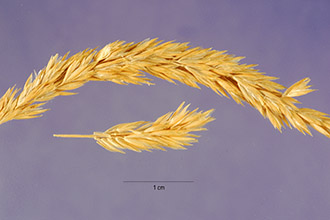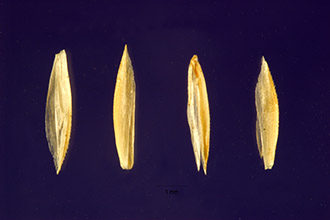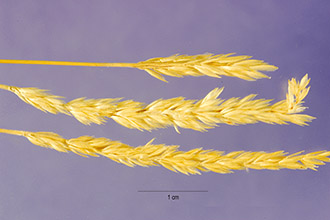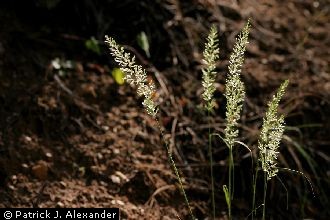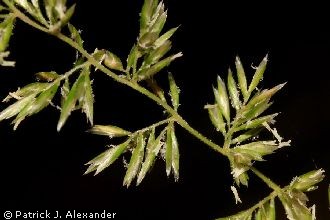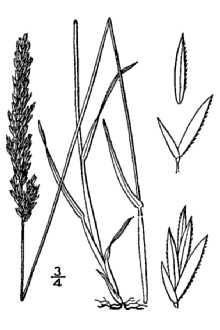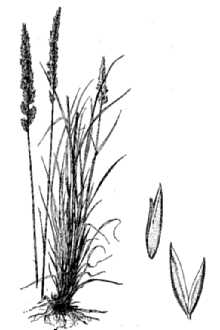Koeleria albescens auct.
Scientific Name: Koeleria albescens auct.
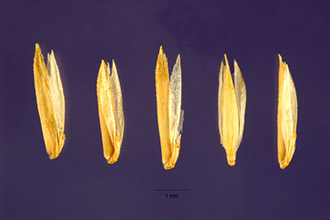
| General Information | |
|---|---|
| Usda Symbol | KOAL5 |
| Group | Monocot |
| Life Cycle | Perennial |
| Growth Habits | Graminoid |
| Native Locations | KOAL5 |
Plant Guide
Alternate Names
Koeleria cristata; Mountain junegrass, junegrass,
Uses
Grazing/Livestock – Prairie junegrass is a component of many native plant communities. It commonly represents up to 5 percent of the community. It greens up early in the spring and provides good early spring forage and fair late spring forage for livestock. Wildlife – Prairie junegrass is considered a fair to good forage for elk throughout the year and is desirable forage for deer and antelope in the spring and early summer. Reclamation – Prairie junegrass is used as a component of native seed mixtures in revegetation of mined lands, heavy use areas and other surface disturbed lands.
Status
Consult the PLANTS Web site and your State Department of Natural Resources for this plant’s current status (e.g. threatened or endangered species).
Description
General: Prairie junegrass is a native, perennial, cool season tufted bunchgrass found on rangelands, plains and open forestlands, It is commonly 0,5- 2 feet tall, The narrow leaves form small basal clusters from which arise several seedheads, Leaves are basal, flat to in-rolled and sharply pointed, The seedheads are narrow contracted panicles and have the appearance of dense spikes, one per stem, The spikelets are normally pale green to purplish in color, Fine hairs are found on the reproductive stem just below the seedhead, The glumes are sharp and shiny, This is one of the first grasses to green-up in the early spring, Prairie junegrass is a perennial grass of medium longevity found in a wide variety of native plant communities, Intermountain Flora - drawn by Jeanne R, Janish, University of Washington Press, Plant Materials <http://plant-materials,nrcs,usda,gov/> Plant Fact Sheet/Guide Coordination Page <http://plant-materials,nrcs,usda,gov/intranet/pfs,html> National Plant Data Center <http://npdc,usda,gov>
Adaptation
Prairie junegrass is cold, heat and drought tolerant and grows on rangeland meadows, plains, mountain foothills and open forestlands. It does best at 12- 20 inches annual precipitation. It is most commonly found at elevations from 4,000- 8,000 feet, but occurs up to 11,500 feet in the central Rocky Mountains. It is found primarily as a component of native plant communities in open and rocky areas. It is best adapted to well-drained soils such as silts to loams to sandy loams. It prefers 6.5- 8.0 pH soils. It has good tolerance to fire.
Establishment
Prairie junegrass is not recommended for fall or dormant fall seedings. It does best when seeded in the spring. Young plants are subject to thinning by frost heaving and soil cracking during winter and very early spring. The native accessions of this species have an average of 2,300,000 seeds per pound. The full monoculture seeding rate for drill application is 1 PLS pound per acre. Use the appropriate percentage of this rate when planting native seed mixtures. The seed should be planted into a clean, weed-free, firm seedbed at soil surface to 1/8-inch depth because seed requires light to achieve maximum germination. The exclusion of grazing animals until plants become well established is recommended. This may require up to 2- 3 growing seasons.
Management
During the second to third growing season, seedheads will flower in mid-April to mid-June. Seed reaches maturity in July through August depending on latitude and elevation. Fall regrowth can occur if soil moisture conditions are favorable. Prairie junegrass greens up early in the spring. Grazing deferment until plants are 4- 6 inches tall is recommended to ensure the health of the plant and to reduce over-grazing. It is considered good forage in early spring, but as it matures in later spring, it becomes tough and less palatable. This grass has moderate to high tolerance to grazing. Prairie junegrass tends to increase in percent cover following fire events and is very resistant to fire.
Pests and Potential Problems
Prairie junegrass may be vulnerable to some insects such as the striped flea beetle which will cause the leaf tips to wilt.
Environmental Concerns
Concerns
Concerns
Prairie junegrass is medium-lived native species, spreading primarily via seed. It is not considered to be "weedy" or an invasive species, but it can spread into adjoining vegetative communities under ideal climatic and environmental conditions. It does not generally spread from original stands, or if it does spread, the rate of spread is slow.
Seed Production
Seed production of prairie junegrass has been successful under cultivated conditions. Row spacing of 24 inches under irrigation or high precipitation (> 16 inches annual precipitation) to 36 inches under dryland conditions is recommended. Seeding rates for seed production range from 0.75 pound PLS per acre on dryland to 1.0 pound PLS per acre under irrigated conditions. It should be seeded in locations where weeds are well controlled. Prairie junegrass seedlings are not vigorous, are slow to establish and are therefore vulnerable to mechanical (wheel and foot traffic) and chemical damage. Wait until the 3- 5 leaf stage before applying herbicides at a low rate (bromoxynil according to label) or clipping for weed control. Cultivation between rows will be needed for weed control and to maintain row culture. Seed fields are productive for about 4- 5 years. Field moisture during the fall, soil fertility, and plant re-growth determine the yield the succeeding year. Average production of 75 pounds per acre can be expected under dryland conditions in 16- inch plus rainfall areas. Average production of 100- 150 pounds per acre can be expected under irrigated conditions. Harvesting can be completed by direct combining in the hard-dough stage or by windrowing followed by combining. Windrowing may help ensure a more complete threshing and more uniform in ripening. Windrowing also reduces the risk of loss of seed from wind. Seed is generally harvested from early July to late August. Seed must be dried immediately after combining (moisture content should be 12 percent in bins/15 percent in sacks). Not all native ecotypes readily produce viable seed. Many ecotypes generally go through anthesis, but not all will produce viable seed at an economically acceptable level. Cultivars, Improved, and Selected Materials ‘Barkoel’ prairie junegrass is the only release of this species. It originates from Barenbrug, Holland, Oosterhout, The Netherlands. It is a selection of clones after three years of testing under turf conditions. The clones were chosen on basis of good winter color and good seed yield. Barkoel is intended for use as a cool-season turfgrass and not intended for native plantings. Seed is available through Barenbrug USA, PO Box 239, Tangent, OR 97389, (503) 926-5801. A native selection that has been tested since 1986 is nearing release by the Upper Colorado Environmental Plant Center in Meeker, CO. No other releases are presently available. Contact your local Natural Resources
Conservation
Service (formerly Soil Conservation Service) office for more information. Look in the phone book under ”United States Government.” The Natural Resources Conservation Service will be listed under the subheading “Department of Agriculture.”
References
Alderson, J. and W. C. Sharp. 1994. Grass varieties in the United States. Agriculture Handbook No. 170. USDA, SCS, Washington, DC. Cornforth, B., L. St. John and D. G. Ogle. 2001. Technical Note 14: Seed production standards for conservation plants in the Intermountain West. USDA-NRCS, Boise, ID. 15p. Cronquist, A., A.H. Holmgren, N.H. Holmgren and J.L. Reveal. 1977. Intermountain Flora: Vascular Plants of the Intermountain West, U.S.A. The New York Botanical Garden. Hitchcock, A.S. (rev. A. Chase). 1950. Manual of the grasses of the United States. USDA Misc. Publ. No. 200. Washington, DC. 1950. Ogle, D. G., L. St. John, M. Stannard and L. Holzworth. 2006. Technical Note 24: Grass, grass- like, forb, legume, and woody species for the intermountain west. USDA-NRCS, Boise, ID. 42p. Smith, R., S. Smith, R. Haas, and L. Holzworth. 1998. Native Grass Seed Production Manual, USDA-NRCS, Bismarck, ND and Ducks Unlimited Canada. 155 p. USDA, NRCS. 2006. The PLANTS Database, Version 061010. (http://plants.usda.gov). National Plant Data Center, Baton Rouge, LA USA.
Fact Sheet
Alternate Names
Other scientific names include Aira cristata L., Aira macrantha Ledeb., Koeleria mukdenensis Domin, Koeleria cristata (L.) Pers., Koeleria gracilis Pers., Koeleria mukdenensis Domin, Koeleria nitida Nutt., Koeleria yukonensis and Koeleria pyrmidata (Lam.) Beauv. Common names include Junegrass, mountain Junegrass, and crested hairgrass.
Uses
Prairie Junegrass is useful in seed mixes for restoration of native prairie, savanna, coastal scrub, chaparral and open forest habitats across much of North America. Good drought tolerance and fibrous roots make it useful for revegetation and erosion control on mined lands, over septic systems, and on construction sites, burns and other disturbed areas. Active growth begins early in spring providing good forage for livestock, deer, antelope and elk. Declining palatability during seed formation rebounds in late summer where there is adequate moisture. Bighorn sheep and mountain goats graze this species from rocky soils at high elevation. It provides feed for upland game birds, small mammals, and numerous grasshoppers and leafhoppers. Prairie Junegrass may also be cultivated for forage or fodder and is used as a low input turfgrass (e.g. golf courses) and as an ornamental grass. Native Americans used the seeds to make flour for bread and mush. They also fashioned paint brushes and brooms from the leaves.
Status
Prairie Junegrass is considered endangered in Ohio and Kentucky and critically impaired in Louisiana. Consult the PLANTS Web site and your State Department of Natural Resources for this plant’s current status (e.g. threatened or endangered species, state noxious status, and wetland indicator values).
Description
Prairie Junegrass is a highly variable, moderately long-lived, cool season perennial bunchgrass that grows 0.5 to 2 ft. tall. Clusters of narrow, markedly veined, light green to bluish green leaves grow to about 7 in. tall. The leaves are flat to in-rolled with slightly rough edges and boat-shaped, pointed tips. Erect seedheads appear as dense, pale green to purplish spikes, tapered at both ends, and 2 to 5 in. long, that are often held well above the foliage. They fluff open somewhat during flowering. There are 2 to 4 flowers per spikelet.
Adaptation
Prairie Junegrass is adapted to a wide variety of climates, soils and native plant communities. The North American distribution of this circumpolar species ranges from eastern Alaska, down through California into Mexico, and east to Alabama, Delaware, and Ontario. For additional information on distribution, consult the Plant Profile page for this species on the PLANTS Web site. Prairie Junegrass is most commonly found on rocky to sandy loam soils of low fertility but also occurs on clay bearing soils with adequate drainage. This plant prefers a soil pH of 6.0 to 8.0. A frequent component of both seral and climax plant communities from 4,000 to 12,000 ft., prairie Junegrass occasionally dominates northern plains mixed prairie. Depending upon seed source, it tolerates cold, heat, drought, fire and serpentine soils. It does not tolerate high soil salinity. Line drawing courtesy of University of Washington Press
Establishment
Prairie Junegrass seed has little dormancy following cold storage through winter and is generally planted in spring, There are about 1,8 million seeds per pound (+/- 20%) although viability is often below 50 percent, Use soil moisture sensors to measure the soil moisture of Koeleria albescens auct.., For seed production, 0,75 to 2 lb, PLS (pure live seed) per acre is drilled shallowly (for light exposure) in rows 24 to 36 in, apart, depending on available irrigation or rainfall, Narrower (12 in,) rows may be used where cultivation between rows is not required, At least 1 lb, per acre is used to seed pasture which may require 2 to 3 years for establishment prior to grazing, Application of fertilizer to wild ecotypes is usually not recommended, Selective herbicides are available for seed production fields or to aid in pasture or native habitat establishment,
Management
Prairie Junegrass flowers in April to June and seed matures in July or August depending upon location and climate. Once established, it will tolerate moderate grazing to 3 or 4 in., even during the fall months as long as moisture is available to stimulate re-growth. In park settings, this grass tolerates foot traffic better than many other native grasses. At least partially due to its small stature, prairie Junegrass is very resistant to fire and will often increase in percent cover after a fire or other disturbance. In turf settings, this species tolerates repeated low mowing.
Pests and Potential Problems
Prairie Junegrass is often free of significant insect and disease problems but is occasionally the target of striped flea beetles, rusts, leaf spots or blights.
Environmental Concerns
Prairie Junegrass usually spreads slowly if at all, and only by seed. However, it played an important role in prairie revegetation following severe drought and dust storms in the 1930s. It generally provides 5% or less of the herbaceous cover in natural settings. Cultivars, Improved, and Selected Materials ‘Barkoel’ prairie Junegrass is an improved cool-season turfgrass cultivar developed from plants native to northern Europe. ‘Barkoel’ seed is available from Barenbrug USA, Tangent, OR. Two native germplasms selected for roadside planting, prairie restoration, and landscaping have been released from the Elsberry Plant Materials Center in Elsberry, IA.
Prepared By
Pete Gonzalves and Dale Darris, USDA NRCS, Plant Materials Center, Corvallis, Oregon
Plant Traits
Growth Requirements
| Temperature, Minimum (°F) | -38 |
|---|---|
| Adapted to Coarse Textured Soils | Yes |
| Adapted to Fine Textured Soils | No |
| Adapted to Medium Textured Soils | Yes |
| Anaerobic Tolerance | None |
| CaCO3 Tolerance | High |
| Cold Stratification Required | No |
| Drought Tolerance | High |
| Fertility Requirement | Medium |
| Fire Tolerance | High |
| Frost Free Days, Minimum | 150 |
| Hedge Tolerance | None |
| Moisture Use | High |
| pH, Maximum | 8.0 |
| pH, Minimum | 6.0 |
| Precipitation, Maximum | 20 |
| Precipitation, Minimum | 14 |
| Root Depth, Minimum (inches) | 20 |
| Salinity Tolerance | None |
| Shade Tolerance | Tolerant |
Morphology/Physiology
| After Harvest Regrowth Rate | Moderate |
|---|---|
| Toxicity | None |
| Shape and Orientation | Erect |
| Nitrogen Fixation | None |
| Resprout Ability | No |
| Active Growth Period | Spring and Fall |
| Bloat | None |
| C:N Ratio | Medium |
| Coppice Potential | No |
| Fall Conspicuous | No |
| Fire Resistant | No |
| Flower Color | Yellow |
| Flower Conspicuous | No |
| Foliage Color | Green |
| Foliage Porosity Summer | Moderate |
| Foliage Texture | Fine |
| Low Growing Grass | No |
| Lifespan | Short |
| Leaf Retention | No |
| Known Allelopath | No |
| Height, Mature (feet) | 1.5 |
| Growth Rate | Rapid |
| Growth Form | Bunch |
| Fruit/Seed Conspicuous | No |
| Fruit/Seed Color | Brown |
| Foliage Porosity Winter | Porous |
Reproduction
| Vegetative Spread Rate | None |
|---|---|
| Small Grain | No |
| Seedling Vigor | Low |
| Seed Spread Rate | Slow |
| Seed per Pound | 2315000 |
| Fruit/Seed Persistence | No |
| Propagated by Tubers | No |
| Propagated by Sprigs | No |
| Propagated by Sod | No |
| Propagated by Seed | Yes |
| Propagated by Corm | No |
| Propagated by Container | No |
| Propagated by Bulb | No |
| Propagated by Bare Root | No |
| Fruit/Seed Period End | Summer |
| Fruit/Seed Period Begin | Summer |
| Fruit/Seed Abundance | Low |
| Commercial Availability | Routinely Available |
| Bloom Period | Late Spring |
| Propagated by Cuttings | No |
Suitability/Use
| Veneer Product | No |
|---|---|
| Pulpwood Product | No |
| Protein Potential | Medium |
| Post Product | No |
| Palatable Human | No |
| Palatable Graze Animal | High |
| Palatable Browse Animal | Medium |
| Nursery Stock Product | No |
| Naval Store Product | No |
| Lumber Product | No |
| Fodder Product | Yes |
| Christmas Tree Product | No |
| Berry/Nut/Seed Product | No |

